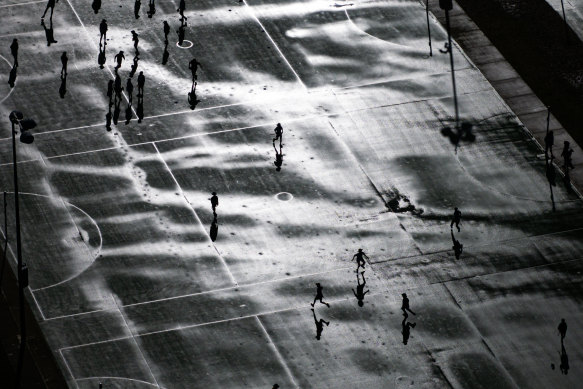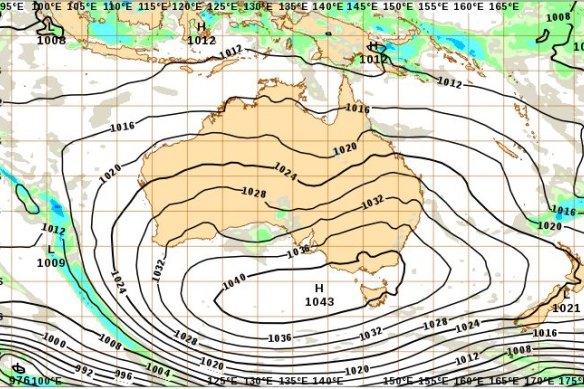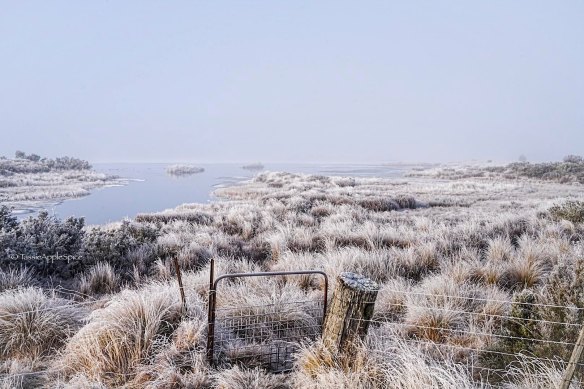Record-breaking weather system brings rain and freezing mornings
By Angus Dalton
Australia’s strongest high-pressure system in almost 60 years has delivered some of the iciest mornings on record to Victoria and Tasmania, while ushering Antarctic wind and rain to Sydney and the rest of the east coast.
The slow-moving high or “anticyclone” could lead to the highest ever atmospheric pressure recording in Australia on Saturday morning.

Drizzling and dribbling: Schoolchildren in Dee Why, Sydney, play on wet netball and basketball courts on Friday.Credit: Nick Moir
A weather station at Sheffield, Tasmania, made a preliminary pressure recording of 1044.6 hectopascals (hPa) on Thursday morning, which would have broken the previous record of 1044.3 hPa set in Launceston in 1967.
But quality checks revealed the reading was erroneous and the pressure was actually 1042.5, the Bureau of Meteorology’s Dean Narramore said.
“But the high pressure is likely to move over Tasmania as we’re moving into tonight, particularly on Saturday and Sunday,” Narramore said. “So we could see some of those numbers go up.”
High-pressure systems drive away rain clouds and are associated with clear, cold skies in winter for areas below the centre of the system.

An abnormally strong high-pressure system is dominating Australia’s weather, bringing moist onshore winds to NSW and record-breaking cold to Victoria.Credit: Bureau of Meteorology
But winds rotate anticlockwise around highs, and the anticyclone’s southern location means the system is whipping Antarctic air up from the south and onto Australia’s east coast.
Those onshore winds are delivering moisture to coastal NSW and Queensland, with drizzle expected at the weekend along the coast, including up to nine millimetres of rain on Friday in Sydney and sporadic showers across Saturday and Sunday.
Areas closer to the centre of the high in south-east Australia are waking up to freezing temperatures because the high’s light winds and clear skies create “the perfect conditions for heat to escape overnight”, the Bureau of Meteorology’s Christie Johnson said.
Liawenee in Tasmania, lived up to its nickname of “Australia’s coldest town” when residents shivered through a minus 13.5 degree night on Thursday, the second-ever coldest night in the state.

The system has delivered freezing mornings to Melbourne.Credit: Joe Armao
Warrnambool, on the Great Ocean Road in Victoria, hit a record July low of minus 2.4.
The bureau forecasts a chilly morning of one degree in Melbourne on Sunday, a minimum temperature five below average for July.
“Australia’s lowest temperatures always occur under the influence of high-pressure systems exacerbating overnight cooling in winter,” Weatherzone’s Ben Domensino said.
“This was the case when Australia registered its lowest temperature on record, with minus 23°C at Charlotte Pass, NSW, in June 1994.”
The current record-threatening high drifted across the Great Australian Bight last week and became locked over Tasmania due to a split in the jetstream, rivers of fast-moving atmospheric air that usually usher weather systems eastward.
Atmospheric highs in winter normally hit about 1022 to 1025 hPa. The pressure over parts of Tasmania was sitting at 1043 hPa on Friday morning.
High-pressure systems force the sea level lower by about one centimetre per hectopascal, so the bureau expects sea levels near the centre of the high to be about 30 centimetres lower than usual. (Low-pressure systems during storms have the opposite effect and exacerbate coastal flooding.)
The frequency and intensity of highs has increased over the past few decades in Australia, bringing more spells of dry, clear weather.

A freezing morning in central Tasmania this week.Credit: Robyn Lewis
The Examine newsletter explains and analyses science with a rigorous focus on the evidence. Sign up to get it each week.